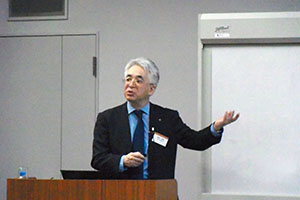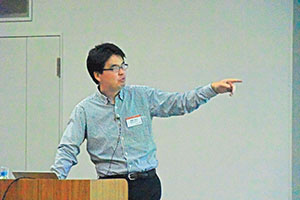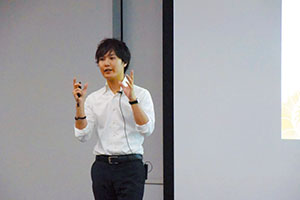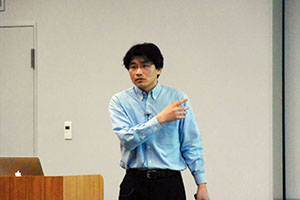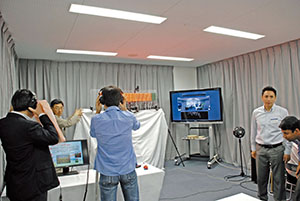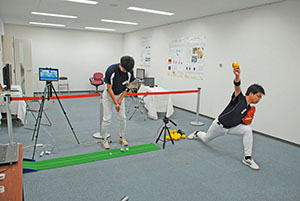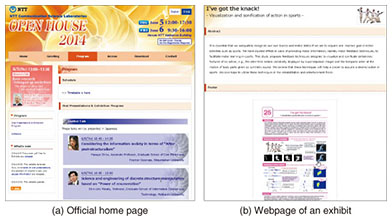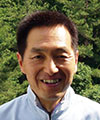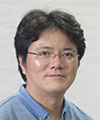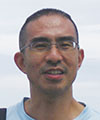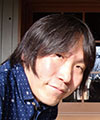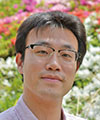 |
|||||
|
|
|||||
|
Information Vol. 12, No. 11, pp. 116–121, Nov. 2014. https://doi.org/10.53829/ntr201411in2 Report on NTT Communication Science Laboratories Open House 2014AbstractOpen House 2014 was held at NTT Communication Science Laboratories in Keihanna Science City, Kyoto, on June 5 and 6. Over 1000 people visited the facility to enjoy 6 talks and 29 exhibits introducing our latest research activities and efforts in the fields of information and human sciences. Keywords: information science, human science, big data 1. OverviewAt NTT Communication Science Laboratories (NTT CS Labs), we aim to build a new technical infrastructure connecting people and information, and we are studying aspects of both human and information sciences to create innovative technologies and discover new principles. NTT CS Labs deals with the most fundamental research targets in the fields of human and information sciences of NTT laboratories; our facilities are located in Kansai Science City (Seika-cho, Kyoto) and Atsugi City, Kanagawa. NTT CS Labs Open House has been held annually with the aim of introducing the results of the labs’ basic research and innovative leading-edge research to both NTT Group employees and visitors from industries, universities, and research institutions who are engaged in research, development, business, and education. This year, Open House was held at the NTT Keihanna Building in Kyoto on the afternoon of June 5 and all day on June 6, and a total of around 1070 visitors attended it over the two days. At this event, we prepared many hands-on exhibits to allow visitors to intuitively understand our latest research results and to share a vision of the future where new products based on the research results are widely used. We also organized an invited talk on the theme of philosophy, which differs from our research fields, so that people in various fields could take an interest in our activities. This report summarizes the event’s research talks and exhibits. 2. Keynote speechOpen House started with a speech by the Director of NTT CS Labs, Dr. Eisaku Maeda, entitled “Basic research: Defining our age and the future—The origin of ideas and the seeds of innovation” (Photo 1).
It has been 14 years since NTT CS Labs was reorganized as the sole basic research institution for human and information sciences under the new NTT research and development (R&D) scheme instituted by the reorganization of NTT in 1999. During this time, NTT CS Labs has established a framework that has enabled the gradual penetration into the world of the technologies developed from their basic research. Dr. Maeda considered this time to be a major turning point for the next step of NTT CS Labs, and he talked about how important it is that basic research tackles problems that have to be selected and solved in line with the times. He also stressed the importance of launching products onto the market based on a sense of urgency required by the times. He then introduced two representative products, i.e., the seeds of innovation: an extremely large vocabulary recognition decoder that is a core part of a minute-taking system used at the House of Representatives, and the Robust Media Search (RMS) technology for music copyright clearance that has been adopted by broadcasters. He also demonstrated Buru-Navi3, the newest version of a haptic compass, which utilizes human sensory properties to induce a pseudo-attraction force. It was successfully miniaturized through a consistent research effort, which is the “origin of ideas” he refers to in the title of his speech. 3. Research talksThere were three talks, which highlighted recent significant research results and high-profile research themes.
Each presentation introduced some of the latest research results and provided some background and an overview of the research. All of the talks were very well received. 4. Research exhibitsOpen House featured 23 exhibits displaying NTT CS Labs’ latest research results. They were classified into three categories: computer science, media intelligence, and communication and human science. Open House also included a special category on big data science that consisted of three exhibits from NTT CS Labs and three from other NTT laboratories. Each exhibit was housed in a booth and employed techniques such as slides on a large-screen monitor or hands-on demonstrations, with researchers explaining the latest results directly to visitors. The following list summarizes the research exhibits in each category. 4.1 Big Data Science
4.2 Computer Science
4.3 Media Intelligence
4.4 Communication and Human Science
The exhibit “Capturing sound by light” introduced a new multichannel system that is capable of capturing audio signals of huge microphone arrays via LEDs (light-emitting diodes) and a high speed video camera. The system achieves real-time performance by massive parallel processing with a single graphics processing unit. Visitors to this exhibit were able to experience demonstrations in which an observed sound space was quickly rebuilt with realistic sensations (Photo 5).
The “I’ve got the knack!” exhibit introduced effective ways of providing motor information, i.e., motor feedback techniques, to facilitate motor learning in sports. These feedback techniques were designed to visualize and convert to sound certain key features of an action. They can be applied not only in the field of sports but also in the rehabilitation and entertainment fields (Photo 6).
5. Invited talkThis year’s event also featured two invited talks by Associate Prof. Masaya Chiba, Graduate School of Core Ethics and Frontier Sciences, Ritsumeikan University, and Prof. Shin-ichi Minato, Graduate School of Information Science and Technology, Hokkaido University. The titles of their respective talks were “Considering the information society in terms of ‘After post-structuralism’” and “Science and engineering of discrete structure manipulation based on ‘Power of enumeration.’” Associate Prof. Masaya Chiba began with a brief review of his research field. Then he described the concepts of structuralism and post-structuralism stemming from 20th-century French philosophy, and provided a simple explanation of the discussions and considerations arising after post-structuralism in relationship to social networks and communications. He suggested that in contemporary society, we need to appropriately control connection and disconnection with other people since we have lapsed into a state of excess connection due to the always-on Internet connection. Prof. Shin-ichi Minato talked about his concept of discrete structure manipulation. In the first half of his talk, he simply explained the technical aspects of the concept using some examples of set expressions and set operations based on the zero-suppressed decision diagram (ZDD) that he developed. In the second half, he explained how discrete structure manipulation was applied to actual problems. He focused on enumeration problems and discussed detailed applications of ZDD as shown in a popular and interesting YouTube video called “Don’t count naively” produced by his group. He also discussed the Graphillion software package for search, optimization, and enumeration for large-scale graphs, and optimization of power distribution networks. 6. Information transmission using webNTT CS Labs has made continuous efforts to inform a large number of people both domestically and internationally about their research activities and results. As part of the ongoing effort, we simultaneously released both Japanese and English websites [1, 2] for Open House 2014, which included a booklet, exhibition posters, and reference information (Fig. 1). We plan to upload photos of the presentation and exhibition halls and videos of the director’s keynote speech and the three research talks.
The members of NTT CS Labs consider it important to transmit high-quality and attractive information on a timely basis. They also have a clear awareness that it is important to convey information on the professional research activities that are underway at the basic research laboratories to a wide range of people in ways that are easy to understand. Consequently, we simply tweeted about the exhibition contents via Twitter through NTT’s Public Relations Office, and we gathered feedback by putting up a questionnaire page on the Open House 2014 websites. NTT CS Labs is continuously trying to improve the ways of disseminating our research activities and results. 7. Concluding remarksJust as they did last year, many visitors came to NTT CS Labs’ Open House 2014 and engaged in lively discussions on the research talks and exhibits and provided many valuable opinions on the presented results. In closing, we would like to offer our sincere thanks to all of the visitors and participants who attended this event. References
|
|||||









